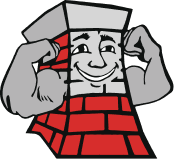We provide a number of chimney sweep services like chimney chase top installation, chimney inspections, and chimney cap replacement to residents in towns like West Hartford, Avon, Simsbury, West Simsbury, Canton, Burlington, Bloomfield, Unionville, Weatogue.
 A chimney chase top is the metal covering used for a wood-framed chimney chase. Chase tops are found on chimneys connected to factory-built fireplaces. The chase is a wood framed structure that contains the double walled chimney pipe used with manufactured fireplaces. These structures can be covered with siding to match the home, stone or brick facing. Resembling the lid of shoebox, these covers are generally standard with pre-fabricated fireplaces and are found on a number of modern builds. Since these particular chimney tops are usually crafted with cheap galvanized sheet metal, they often rust quickly and will need replaced every 7 to 10 years.
A chimney chase top is the metal covering used for a wood-framed chimney chase. Chase tops are found on chimneys connected to factory-built fireplaces. The chase is a wood framed structure that contains the double walled chimney pipe used with manufactured fireplaces. These structures can be covered with siding to match the home, stone or brick facing. Resembling the lid of shoebox, these covers are generally standard with pre-fabricated fireplaces and are found on a number of modern builds. Since these particular chimney tops are usually crafted with cheap galvanized sheet metal, they often rust quickly and will need replaced every 7 to 10 years.
A damaged or deteriorated chimney chase top can lead to serious and expensive water damage, which is why it’s important to have your chimney inspected annually to ensure your chimney chase top is in good condition. If the cover begins to corrode or crack, water and debris can enter your chimney system leaving it vulnerable to dangerous blockages, chimney fires, or a backup of carbon monoxide.
Homeowners will be able to detect a deteriorating chimney chase top since water from a rusty chase cover will cause unsightly discoloration on the chimney as rusty water runs off the deteriorating top. The heat produced from a burning fire along with other environmental exposure contributes to the degradation of the galvanized coating on the chimney chase tops. As the galvanized coating disappears, the metal is left unprotected and will begin to rust. At this point, replacement should be done immediately to prevent serious water damage or other issues like mold, wood rot, etc.
 Issues Caused by Deteriorated Chimney Chase Tops
Issues Caused by Deteriorated Chimney Chase Tops
Chimney chase tops, along with chimney caps & chimney shrouds, are an important feature of your chimney system that prevents water, leaves, twigs, debris, and small animals from getting into your chimney chase and causing damage or blockages. Water is a chimney’s worst enemy, and without a proper chimney chase top, moisture can seep into the chase structure, causing expensive damage that could end up comprising the entire structural integrity of your chimney. Common issues caused by moisture in your chimney system include mold, rotting wood frame, walls & beams, deterioration and corrosion of your firebox, degradation of your chimney pipe.
Chimney Chase Top Designs
The chimney chase top should match the exact specifications of your chimney chase. A buffer of ¼ to ½ inch is needed all the way around the chimney top and the cover should sit 1/8 to ¼ of an inch above the chase to allow for proper ventilation and air flow. Chimney chase tops have large round band call a storm collar that diverts water away from the termination cap that extends up through the center of the chimney chase cover, allowing air to be drawn in for combustion and for gases and smoke to escape up the chimney pipe.
Types of Chimney Chase Tops
The most popular materials used to construct chimney chase tops are galvanized steel, copper, stainless steel, and aluminum. Each type has its own advantages and disadvantages. Here’s how to choose:

Galvanized Steel
These chimney chase tops are the least expensive but generally rust quicker than other materials so will need to be replaced every few years.
Copper
When it comes to quality, copper can’t be beat. It is considered to be the highest of quality and is typically the most expensive. Many homeowners choose a copper chase top not only for the longevity, but also for the aesthetic appeal that a copper cover offers.
Stainless Steel
This material is the strongest by far, and also has great longevity. Although it costs a bit more than galvanized steel, it will never rust and will require much less maintenance, giving it an extra-long life. This option is extremely popular among homeowners for good reason.
Aluminum
Aluminum is resistance to rust and corrosion but tends to be damaged easily since it is a softer metal than the alternatives. Although appealing for its price, aluminum is not a great chimney topper for those homes in areas of severe weather or high winds.



